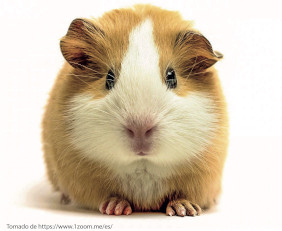Growth of Guinea pigs (Cavia porcellus) with feed for rabbits and supplementation of vitamin C
Crecimiento de cuyes (Cavia porcellus) con alimento para conejos y suplementación de vitamina C

Show authors biography
Objetive. An experiment was conducted to evaluate the feed intake, digestibility and growth of pigs fed with two feeds (A and K) specially formulated for this species and a commercial feed for growing rabbits with supplementation of vitamin C (RF+VC). Materials and methods. Eighteen Guinea pigs of 248±38 g initial body weight were distributed in a completely randomized design with factorial arrangement 3×2 (dietary treatments and sex). Feed and neutral detergent fiber intake, weight gain, feed/gain, and morphometric variables were measured individually for 30 days. Dry matter and neutral detergent fiber digestibility were measured during the last seven days of the experiment. Results. There were no differences on feed intake (p=0.88); however, the dry matter digestibility was higher (p<0.01) in feeds formulated for Guinea pigs (A and K) and lower in the rabbit feed plus vitamin C. The intake and digestibility of NDF were higher in the RF+VC and lower in feeds for Guinea pigs (p< 0.01). The average daily gain was similar among the treatments (p>0.05). There were no differences (p>0.01) in the morphometric variables among dietary treatments, but there were sex differences as the males were bigger than the females (p<0.01). Conclusions. The results indicate that Guinea pigs can be fed with rabbit feed supplemented with vitamin C.
Article visits 9145 | PDF visits
Downloads
- Dunnum JL, Salazar-Bravo J. Molecular systematics, taxonomy and biogeography of the genus Cavia (Rodentia: Caviidae). J Zool Syst Evol Res. 2010; 48(49:285-392. https://doi.org/10.1111/j.1439-0469.2009.00561.x
- Lossi L, D’Angelo L, De Girolamo P, Merighi A. Anatomical features for an adequate choice of experimental animal model in biomedicine: II. Small laboratory rodents, rabbit, and pig. Ann Anat. 2016; 204:11-28. https://doi.org/10.1016/j.aanat.2015.10.002
- Meredith A. Guinea pigs: common things are common. Vet Record. 2015; 177(8):198-199. https://doi.org/10.1136/vr.h4465
- Yang H. Conserved or lost: Molecular evolution of the key gene GULO in vertebrate vitamin C biosynthesis. Biochem Genet. 2013; 51(5-6):413-425. https://doi.org/10.1007/s10528-013-9574-0
- NRC (National Research Council). Nutrient Requirements of Laboratory Animals. Subcommittee on Laboratory Animal Nutrition, Committee on Animal Nutrition, Board on Agriculture. National Academy Press. Washington DC, USA; 1995. https://doi.org/10.17226/4758
- AOAC (Association of Official Analytical Chemists). Official methods of analysis. 15 ed. AOAC, Arlington, VA, USA; 1990.
- Van Soest JP, Robertson JB, Lewis BA. Methods for dietary fiber, neutral detergent fiber and nonstarch polysaccharides in relation to animal nutrition. J Dairy Sci. 1991; 74(10):3583-3597. https://doi.org/10.3168/jds.s0022-0302(91)78551-2
- Van Keulen J, Young B. Evaluation of acid-insoluble ash as a natural marker in ruminant digestibility studies. J Anim Sci. 1977; 44(2):282-287. https://doi.org/10.2527/jas1977.442282x
- Herrera-Haro JP, García-Artiga C. Bioestadística en ciencias veterinarias. Universidad Computlense de Madrid: Madrid España; 2011. https://books.google.com.co/books/about/Bioestad%C3%ADstica_en_ciencias_veterinarias.html?id=qTEsngEACAAJ&redir_esc=y
- Meyer K, Hummel J, Clauss M. The relationship between forage cell wall content and voluntary food intake in mammalian herbivores. Mammal Rev. 2010; 40(3):221-245. https://doi.org/10.1111/j.1365-2907.2010.00161.x
- Brownlee IA. The physiological roles of dietary fibre. Food Hydrocolloid. 2011; 25(2):238–250. https://doi.org/10.1016/j.foodhyd.2009.11.013
- Morales MA, Carcelén CF, Ara GM, Arbaiza FT. Chauca FL. Effect of two energy levels on the productive performance of Guinea Pigs (Cavia porcellus) of the Peru breed. Rev Inv Vet Perú. 2011; 22(3):177-182. https://doi.org/10.15381/rivep.v22i3.254
- Pascual M, Cruz DJ, Blasco A. Modeling production functions and economic weights in intensive meat production of guinea pigs. Trop Anim Health Prod. 2017; 49(7):1361-1367. https://doi.org/10.1007/s11250-017-1334-4 .
- Regand A, Chowdhury Z, Tosh SM, Wolever TMS, Wood P. The molecular weight, solubility and viscosity of oat beta-glucan affect human glycemic response by modifying starch digestibility. Food Chem. 2011; 129(2):297-304. https://doi.org/10.1016/j.foodchem.2011.04.053
- Franz R, Kreuzer M, Hummel J, Hatt JM, Clauss M. Intake, selection, digesta retention, digestion and gut fill of two coprophageous species, rabbits (Oryctolagus cuniculus) and guinea pigs (Cavia porcellus), on a hay-only diet. J Anim Physiol Anim Nutr. 2011; 95(5):564-570. https://doi.org/10.1111/j.1439-0396.2010.01084.x
- Acheneje ESS, Husseini G, Silas T, Musa TC. Effect of Sex on Linear Body Measurements of Guinea Pig (Cavia porcellus) AU J T. 2010; 14(1):61-65. http://www.journal.au.edu/au_techno/2010/jul2010/journal141_article08.pdf























